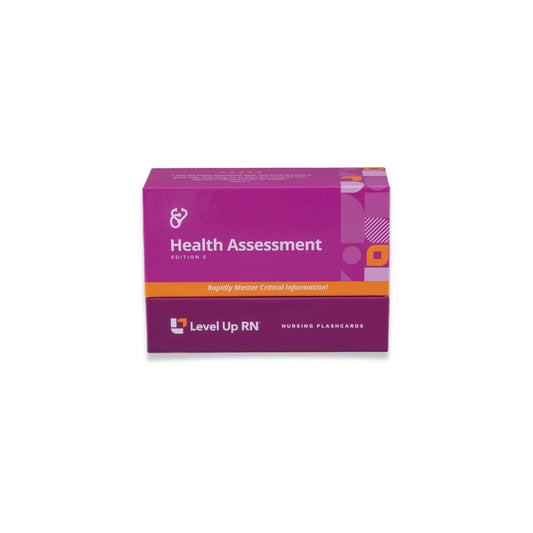When you see this Cool Chicken, that indicates one of Cathy's silly mnemonics to help you remember. The Cool Chicken hints in these articles are just a taste of what's available across our Level Up RN Flashcards for nursing students!
In this article, we cover types of temperatures (at which sites a patient's body temperature can be read), expected temperature ranges for adults and children, and important nursing considerations for temperature assessment.
The Health Assessment video series follows along with our Health Assessment - Nursing Flashcards, which are intended to help RN and PN nursing students study for nursing school exams, including the ATI, HESI, and NCLEX.
Health Assessment - Nursing Flashcards
Types of temperatures
The different types of temperatures that can be assessed include oral, temporal, tympanic, axillary, and rectal.
Oral temperature
Oral temperature is the most common type of temperature that you will take in patients who are adults, who are alert and oriented, able to follow commands. Oral temperature is the one that you will probably be the most well-versed in.
To take an oral temperature, place the temperature probe in the patient's posterior sublingual pocket (underneath the patient's tongue all the way in the back, on either side) and instruct them to close their lips around the probe.
Temporal temperature
You're probably very well versed with a temporal temperature because this is how we assessed the temperature of most people out and about in the world during the height of the COVID-19 pandemic.
To take a temporal temperature, slide the probe from the center of the patient's forehead, all the way to the hairline behind the ear.
Tympanic temperature
A tympanic temperature is an assessment of the temperature of the tympanic membrane, which is inside the ear.
To take a tympanic temperature for an adult, or anyone over 3 years old, pull the pinna up and back. To take a tympanic temperature for a child under 3, pull the pinna down and back.
Why is the method different? Children have a different anatomy than adults, including the structure of their inner ear—this is why children oftentimes struggle with ear infections. So when taking a tympanic temperature on a child, you need to straighten out their ear canal in a different way than we would an older child or an adult.
Axillary temperature
Axillary means in the axilla, or the armpit.
To take an axillary temperature, place the probe in the center of the axilla and have the patient bring down their arm close to the body.
Rectal temperature
Rectal temperature is a temperature taken via rectum, which is considered the most accurate temperature.
To take a rectal temperature, place the patient in a modified left lateral recumbent position, so that you can access the rectum more easily. Use a water-based lubricant and insert the temperature probe approximately one inch and angle it towards your patient's umbilicus (belly button).
Expected temperature ranges
Expected temperature ranges differ for adults, children, and infants.
Expected temperature ranges for adults
The expected temperature ranges for an adult are 96.8 - 100.4° F, or 36 - 38° C.
Expected temperature ranges for children and infants
The expected temperature range for children and infants is 97.4 - 99.6° F, or 36.3 - 37.6° C.
Note that the children and infants have a slightly narrower expected temperature range.
Temperature assessment nursing considerations
There are a few things to be aware of when it comes to temperature assessment in your nursing practice.
What is a fever?
An adult's temperature is not a fever until it is over 100.4° F.
So, if you have a patient who says that they've been running a fever, but their temperature is 99.8° F—know that's not technically a fever.
What can affect a temperature reading?
Food and fluid can alter a temperature reading. Wait at least 15 minutes after the patient's last oral intake before taking an oral temperature.
Which type of temperature reading is the most accurate?
Rectal temperature is considered to be the most accurate. This is what we call a core body temperature.
If you have a patient whose oral or axillary temperature will not give a reading, you may need to get a rectal temperature.
Also, most facilities have a specific, designated temperature probe that can be used for rectal temperatures—make sure to use that.


